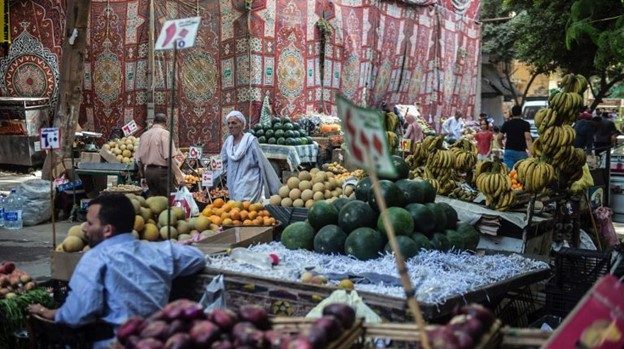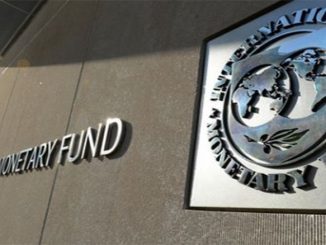
Annual core inflation computed by Central Bank of Egypt records 6.4% in July 2021
Egypt’s Central Agency for Public Mobilization and Statistics (CAPMAS) has revealed that the annual rate of urban inflation rose to 5.4% in July, compared to 4.9% in June 2021. On a monthly basis, it recorded 0.9% in July, compared to 0.2% in June.
In its monthly report issued on Tuesday, the agency noted that the consumer price index for the whole country amounted to 114.4 points in July 2021, an increase of 1% from June 2021.
CAPMAS attributed this rise to the increase in the prices of dairy, cheese, and eggs by 2.2%, meat and poultry by 1.2%, vegetables by 1.1%, tobacco products by 1.7%, electricity, gas, and other fuels by 8.9%, tourist trips by 6.9%, and personal care products by 1.2%. On the other hand, the prices of the fruit group decreased by 3.4%.
According to the agency, the annual inflation for the country recorded 6.1% in July 2021, compared to 5.3% in June 2021, and 4.6% in July 2020.
The annual core inflation rate computed by the Central Bank of Egypt (CBE) recorded 6.4% in July 2021, compared to 3.8% in June. On a monthly basis, the country’s core inflation reached 0.6% in July 2021, compared to -0.1% in July 2020, and 0.1% in June 2021.
The Monetary Policy Committee (MPC) of CBE decided, during its meeting last Thursday, to maintain the basic interest rates for the sixth time in a row, at 8.25% for deposit; 9.25% for lending; and 8.75% for the credit and discount rates, and the price of the main operation.
The committee said the rise in the annual urban inflation during June came as a result of the negative impact of the base period for the second consecutive month, expecting that the negative impact of the base period on annual rates of inflation will continue in the near term.
It indicated that it believes that the basic interest rates at the Central Bank are appropriate at the present time, and are consistent with achieving the target inflation rate of 7% (±2%) on average during the fourth quarter of 2022, and price stability in the medium term.
It affirmed that it will closely follow all economic developments and risk balances and will not hesitate to use all its tools to support the recovery of economic activity, provided that inflationary pressures are contained.
Economist Mohamed Abdel Aal said that expectations indicate a continued rise in the inflation rate during the coming period for various reasons, the most important of which is the impact of potential rises in oil prices, and consumer and strategic goods globally, which may be reflected after a while on the prices of local commodities.
He added that it is also expected that the inflation rate will remain a single digit, between the level targeted by the Central Bank, which is 7% (±2%), i.e. between 5-9%, and in light of this, thinking about any temporary adjustment of interest rates is something that may be unreasonable.
According to Abdel Aal, the current or expected inflation figures, compared to the average yield curve on the pound, still indicate a very reasonable real return difference.
The Research Department at Beltone Financial expected the CBE to keep interest rates during the MPC’s meeting on 16 September.
Beltone indicated, in a report issued today, that the need to maintain investment attractiveness in the fixed income market, especially with the rise in interest rates globally, puts pressure on flows to emerging markets, which supports its vision of fixing interest.
Beltone pointed out that the developments in annual general inflation readings confirm the expected upward trend of inflation, approaching the target range of 7% (±2%) on average by the fourth quarter of 2022.
Egypt’s annual inflation rose slightly to 5.4% in July, compared to 4.9% in June, down from Beltone’s estimates of 6%, indicating an increase of 0.9% on a monthly basis compared to an increase of 0.2% in June, and less than its estimates.
According to Beltone, this came despite the increase in electricity and fuel prices during July, which was reflected in a monthly increase of 2.4% in the housing and utilities sector compared to its slight change in June.
It indicated that the entertainment and culture sector witnessed an increase of 5% on a monthly basis, compared to 2.4% in June, as a result of seasonal spending during the Eid Al-Adha holiday period and the beginning of the summer season.
Beltone expected a rise in the annual general inflation reading in the second half of 2021, with the start of the rise in global prices of commodities gradually reflecting on the local market, in addition to the impact of the comparison periods.
CBE justifies hiking inflation
Egypt’s annual headline urban inflation increased to 5.4% in July 2021, compared to 4.9% in June 2021, mainly affected by unfavorable base effects. This comes as monthly headline urban inflation recorded 0.9% in July 2021, up from 0.4% in July 2020, which reflected the impact of the outbreak of COVID-19 on consumption patterns, especially food items.
Monthly headline urban inflation in July 2021 reflected higher prices of regulated items, core food items, and services.
The increase in basic items prices mainly reflected higher prices of electricity as announced by the Ministry of Electricity, as well as higher tobacco prices in line with the Health Insurance Law’s mandate to increase taxes on tobacco products.
On the other hand, prices of volatile food items continued to decline for the second consecutive month, while prices of retail items remained broadly unchanged.
On an annual basis, the acceleration of the headline inflation figure during July 2021 was driven by the higher annual inflation of food items and was further supported by the higher annual inflation of nonfood items.
Annual food inflation increased for the third consecutive month to reach 4.8% in July 2021 from 3.4% in June 2021, reflecting mainly higher annual contribution of core food items.
In addition, annual nonfood inflation increased slightly to 5.7% in July 2021 from 5.6% in June 2021.
Driven by the higher annual contribution of core food items, annual core inflation increased in July 2021 to 4.6%, from 3.8% in June 2021.
This comes as monthly core inflation recorded 0.6% in July 2021 compared to negative 0.1% in July 2020.
Nationwide annual inflation and annual rural inflation increased to record 6.1% and 6.8% in July 2021, from 5.3% and 5.7% in June 2021, respectively.
Prices of regulated items increased by 2.3%, contributing 0.54% to the monthly headline inflation.
This was mainly due to higher prices of electricity, tobacco products as well as fees for getting official papers.
Prices of fresh vegetables slightly increased by 0.4%, while prices of fresh fruits declined for the second consecutive month by 4.1%. Together, fresh vegetables and fresh fruits contributed by negative 0.07 percentage points to monthly headline inflation.
Prices of eggs increased sharply by 7.7%, to contribute by 0.08% to monthly headline inflation.
Prices of poultry increased by 1.5% after declining for two consecutive months, to contribute by 0.06% to monthly headline inflation.
Prices of red meat increased for the seventh consecutive month by 0.8%, to contribute by 0.03%age points to monthly headline inflation.
Prices of other core food items, including fish and seafood, rice, and oil, increased to contribute by 0.04%age points to monthly headline inflation.
Prices of services increased by 0.5%, to contribute by 0.19% to monthly headline inflation. This was mainly due to higher international travel fees, as well as higher prices of haircuts and rental values.
Prices of retail items increased slightly by 0.1%, to contribute by 0.01% to monthly headline inflation. The slight increase reflected marginally higher prices of personal care products and household appliances.
Monthly core inflation was affected by price changes of the above core CPI items. Core food items contributed by 0.30% to monthly core inflation. In the meantime, services and retail items contributed by 0.26% and 0.01% to monthly core inflation, respectively.



